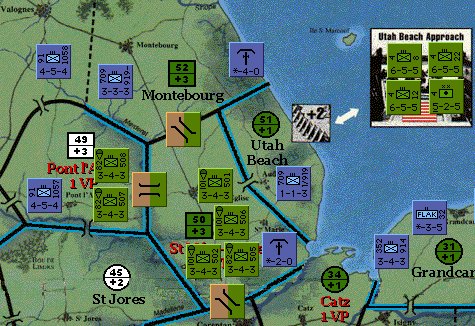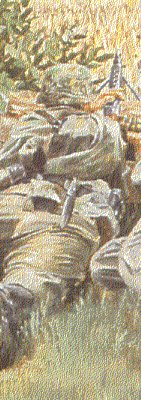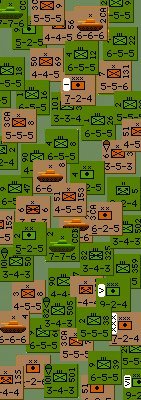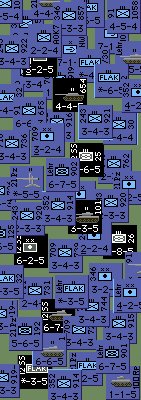
At the World Boardgaming Championships in 2000, Phil Barcafer adopted a new strategy in Ste. Mère-Église (Area 50) that attracted a lot of interest and commentary. The strategy was previously unseen, yet it worked quite well for Phil. Indeed, he won the Breakout: Normandy championship that year!
The orthodox D-Day strategy for the Allies is to deploy two of the four paratroop regiments available in Area 50 to seize the bridges to Carentan (Area 44) and Montebourg (Area 52), leaving the remaining two paratroop regiments fresh. In addition, one of the two available paratroop regiments landing in Pont l'Abbé (Area 49) is deployed to seize the 49/50 bridge. With the Ste. Mère-Église bridges in Allied hands, the Germans are unable to reinforce the Area unless they make a mandatory assault at terrible odds. Moreover, with two paratroop regiments remaining fresh in Ste. Mère-Église the Germans have only a one-in-six chance of seizing back one of the bridges. If the Allies can hold the bridges until June 7, the 325th paratroop regiment of the 82nd division arrives to eliminate any possibility the Germans might seize the bridge back. This gives the Allies all the time they need to land and organize their forces on Utah Beach, storm the 51/50 bridge and free Ste. Mère-Église.
The "Going Postal" strategy is quite unorthodox. Here's how Phil Barcafer described it. "During the paradrop phase, I had the 4 US Airborne units attack the Ste. Mère-Église coastal unit at 7 to 5, needing 3+ on the dice to clear it. I did not get it. I gave up the advantage, rerolled, and won by 5. Ste. Mère was clear before anyone hit the beaches. There was a great risk involved here, but not as much as it seems. If I had lost the second roll, I would have had no bridges. Any opponent could have driven the 6-6-3 from Carentan into Ste. Mère on their first impulse. That would have been bad, but then I would have driven the Brits into Tilly and Villars [through a vacant Bretteville]. So the next German move would by necessity be the Bretteville move, allowing me to bring the 4th division in to attack Ste. Mère, with another chance to clear the Area." (Consimworld Breakout: Normandy folder, #861, August 7, 2000.)

The strategy is indeed risky. The chance of getting a 3+ DR-DIFF is just 24% and the chance of getting it in two attempts (using the advantage to get a re-roll) is 42%. So the approach will work less than half the time. If successful though, the Allies can make an early assault on Carentan and possibly break the game wide open. Of course, if the Allies have to give up the advantage to make the strategy work, the Germans might subsequently use it to declare a double impulse, in order to reinforce Ste. Mère-Église and occupy Bretteville both on the first impulse.
Jim Doughan suggested an "alternative-to-postal" gambit for hitting Ste. Mère-Église hard and early that does not require giving up the advantage (Consimworld Breakout: Normandy folder, #873, August 9, 2000). In the Airborne Phase, the Allies seize the 44/50 bridge as usual, but they seize the 50/51 bridge to Utah Beach instead of the 50/52 bridge to Montebourg. During the Air Bombardment Phase they hit Montebourg, targeting the 709/919(-) infantry battalion with a 56% chance of flipping it. During the Amphibious Assault Phase, only one of the 4th division regiments hits the beach, hoping to clear the Area alone (a 66% probability, provided the defending German 709/1/919 infantry battalion was spent during the Naval Bombardment Phase). During the June 6 Daylight impulses, the Allies can hit Ste. Mère-Église twice at 7-5, using the remaining two 4th division regiments. Unless there is a weather change, the Germans are unable to reinforce the Area because none of their units have sufficient movement factor.
Is "Going Postal" a good strategy? The balance of opinion seems to be "no", since it has not been widely adopted in the past couple of years since Phil Barcafer introduced the gambit. On average the strategy will fail 58% of the time, will succeed without the need to relinquish the advantage 24% of the time, and will succeed at the cost of giving up the advantage 18% of the time. If it works, the Allies certainly get the upper hand at the start of the game. If it fails, the Allies may end up with a stalemate on the Utah Beach front, much as they would if the Germans recapture the "magic" 52/50 bridge on a 1-in-6 die roll, playing the orthodox strategy. The gambit also implies a significant 76% risk the Allies will lose the advantage, though they have a possibility of regaining it via the Omaha "Trifecta". In sum, while the strategy has not become the new orthodoxy, it survives as a reasonable alternative line of attack.
A much more conservative version of the postal tactic, dubbed "third class mail" by Jim Eliason, involves delaying the paratroop assault until late in the day on June 6. If the St. Mère-Église garrison is already weakened by an assault from the 4th infantry, attack with the remaining two fresh paratroopers late on D-Day. Michael Rinella suggests waiting until impulse 9. This move risks little since the Allies will probably have nothing else very useful to do with their impulses late on the opening day of the campaign and even if the attack fails, the day is likely to end.



